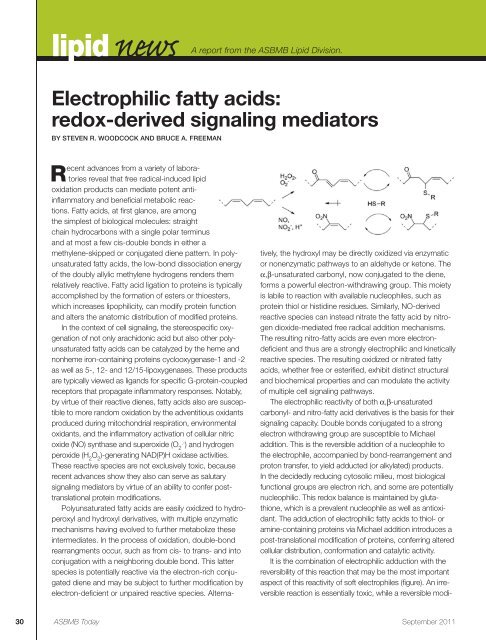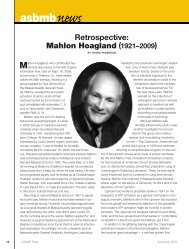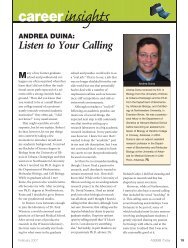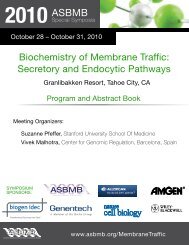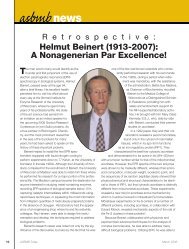asbmbnews
asbmbnews
asbmbnews
Create successful ePaper yourself
Turn your PDF publications into a flip-book with our unique Google optimized e-Paper software.
lipid news<br />
electrophilic fatty acids:<br />
redox-derived signaling mediators<br />
BY STEVEN R. WOODCOCK AND BRUCE A. FREEMAN<br />
Recent advances from a variety of laboratories<br />
reveal that free radical-induced lipid<br />
oxidation products can mediate potent antiinflammatory<br />
and beneficial metabolic reactions.<br />
Fatty acids, at first glance, are among<br />
the simplest of biological molecules: straight<br />
chain hydrocarbons with a single polar terminus<br />
and at most a few cis-double bonds in either a<br />
methylene-skipped or conjugated diene pattern. In polyunsaturated<br />
fatty acids, the low-bond dissociation energy<br />
of the doubly allylic methylene hydrogens renders them<br />
relatively reactive. Fatty acid ligation to proteins is typically<br />
accomplished by the formation of esters or thioesters,<br />
which increases lipophilicity, can modify protein function<br />
and alters the anatomic distribution of modified proteins.<br />
In the context of cell signaling, the stereospecific oxygenation<br />
of not only arachidonic acid but also other polyunsaturated<br />
fatty acids can be catalyzed by the heme and<br />
nonheme iron-containing proteins cyclooxygenase-1 and -2<br />
as well as 5-, 12- and 12/15-lipoxygenases. These products<br />
are typically viewed as ligands for specific G-protein-coupled<br />
receptors that propagate inflammatory responses. Notably,<br />
by virtue of their reactive dienes, fatty acids also are susceptible<br />
to more random oxidation by the adventitious oxidants<br />
produced during mitochondrial respiration, environmental<br />
oxidants, and the inflammatory activation of cellular nitric<br />
oxide (NO) synthase and superoxide (O .-<br />
2 ) and hydrogen<br />
peroxide (H2O2 )-generating NAD(P)H oxidase activities.<br />
These reactive species are not exclusively toxic, because<br />
recent advances show they also can serve as salutary<br />
signaling mediators by virtue of an ability to confer posttranslational<br />
protein modifications.<br />
Polyunsaturated fatty acids are easily oxidized to hydroperoxyl<br />
and hydroxyl derivatives, with multiple enzymatic<br />
mechanisms having evolved to further metabolize these<br />
intermediates. In the process of oxidation, double-bond<br />
rearrangments occur, such as from cis- to trans- and into<br />
conjugation with a neighboring double bond. This latter<br />
species is potentially reactive via the electron-rich conjugated<br />
diene and may be subject to further modification by<br />
electron-deficient or unpaired reactive species. Alterna-<br />
A report from the ASBMB Lipid Division.<br />
tively, the hydroxyl may be directly oxidized via enzymatic<br />
or nonenzymatic pathways to an aldehyde or ketone. The<br />
α,β-unsaturated carbonyl, now conjugated to the diene,<br />
forms a powerful electron-withdrawing group. This moiety<br />
is labile to reaction with available nucleophiles, such as<br />
protein thiol or histidine residues. Similarly, NO-derived<br />
reactive species can instead nitrate the fatty acid by nitrogen<br />
dioxide-mediated free radical addition mechanisms.<br />
The resulting nitro-fatty acids are even more electrondeficient<br />
and thus are a strongly electrophilic and kinetically<br />
reactive species. The resulting oxidized or nitrated fatty<br />
acids, whether free or esterified, exhibit distinct structural<br />
and biochemical properties and can modulate the activity<br />
of multiple cell signaling pathways.<br />
The electrophilic reactivity of both α,β-unsaturated<br />
carbonyl- and nitro-fatty acid derivatives is the basis for their<br />
signaling capacity. Double bonds conjugated to a strong<br />
electron withdrawing group are susceptible to Michael<br />
addition. This is the reversible addition of a nucleophile to<br />
the electrophile, accompanied by bond-rearrangement and<br />
proton transfer, to yield adducted (or alkylated) products.<br />
In the decidedly reducing cytosolic milieu, most biological<br />
functional groups are electron rich, and some are potentially<br />
nucleophilic. This redox balance is maintained by glutathione,<br />
which is a prevalent nucleophile as well as antioxidant.<br />
The adduction of electrophilic fatty acids to thiol- or<br />
amine-containing proteins via Michael addition introduces a<br />
post-translational modification of proteins, conferring altered<br />
cellular distribution, conformation and catalytic activity.<br />
It is the combination of electrophilic adduction with the<br />
reversibility of this reaction that may be the most important<br />
aspect of this reactivity of soft electrophiles (figure). An irreversible<br />
reaction is essentially toxic, while a reversible modi-<br />
30 ASBMB Today September 2011


